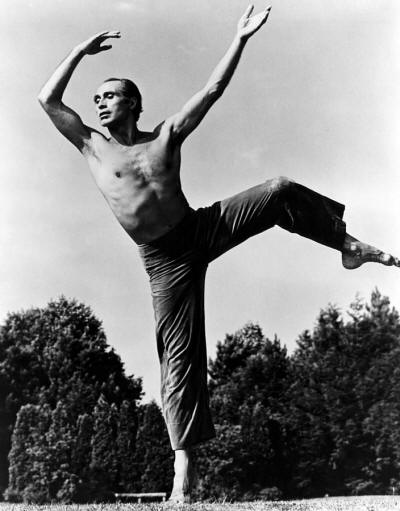

Partner Charles Weidman, Luis Barragán
Queer Places:
31 W 10th St, New York, NY 10011
Jose Limon Dance Foundation, 466 W 152nd St, New York, NY 10031
 José Arcadio Limón (January 12, 1908 – December 2, 1972) was a dancer and choreographer who developed what is now known as 'Limón technique'. In the 1940s he founded the José Limón Dance Company (now the Limón Dance Company), and in 1968 he created the José Limón Foundation to carry on his work.
José Arcadio Limón (January 12, 1908 – December 2, 1972) was a dancer and choreographer who developed what is now known as 'Limón technique'. In the 1940s he founded the José Limón Dance Company (now the Limón Dance Company), and in 1968 he created the José Limón Foundation to carry on his work.
Miguel Covarrubias and Rosa Rolanda were Zeligs of Mexican modernism: the husband and wife painter-choreographer pair crop up in almost all of the movement’s primal scenes. Covarrubias and Rolanda introduced Luis Barragán to José Limón, his erstwhile lover, who poses on black volcanic rocks in a series of photographs that rest on a living room lectern of Barragan's house. They were taken at El Pedregal, a gated development Barragán designed, and whose fusion of modern principles and hacienda architecture signalled Mexico City’s gentrification.
Limón’s traditional Mexican upbringing, with its cultural formality and modesty, made the public display of his body in form-fitting tights a real trauma. But something impelled him. New York audiences had never seen the equivalent of Limón, a tall, exotically handsome, and well-built male dancer. Their rapturous feedback helped mitigate his sensitivity.
The product of a machismo culture, Limón not only chose to work in a female-dominated field, but he was homosexual. He chose a career in which near poverty was nearly guaranteed; this conflicted with his strong Mexican work ethic; there would be no paychecks mailed home to L.A. Yet none of these hardships, conflicts, and even torments, succeeded in putting him off dancing … or off making dances.

In his choreography, Limón spoke to the complexities of human life as experienced through the body. His dances feature large, visceral gestures — reaching, bending, pulling, grasping — to communicate emotion. Inspired in part by his teacher Doris Humphrey's theories about the importance of body weight and dynamics, his own Limón technique emphasizes the rhythms of falling and recovering balance and the importance of good breathing to maintaining flow in a dance. He also utilized the dance vocabulary developed by both Doris Humphrey and Charles Weidman, which aimed at demonstrating emotion through dance in a way that was much less strict and stylized than ballet as well as used movements of the body that felt most natural and went along with gravity.[1] Limón's most well-known work is The Moor's Pavane (1949), based on Shakespeare's Othello, which won a major award.[2] Other works were inspired by subjects as diverse as the McCarthy hearings (The Traitor) and the life of La Malinche, who served as interpreter for Hernán Cortés. Limón generally sets his dances to music, choosing composers ranging from Ludwig van Beethoven and Frederic Chopin to Arnold Schoenberg and Heitor Villa-Lobos.
José Arcadio Limón was born January 12, 1908 in Culiacán,[3] Mexico, the eldest of twelve children. In 1915, his family moved to Los Angeles, California.[3] After graduating from Lincoln High School, Limón attended UCLA as an art major. He moved to New York City in 1928 to study at the New York School of Design. In 1929, he was inspired to dance after attending one of Harald Kreutzberg and Yvonne Georgi's performances and enrolled in the Humphrey-Weidman school.[4]
When José Limón arrived in New York City in 1929, the term used to discuss male gender and sexuality operated within a different set of values and meanings than those currently held. George Chaunchey argued that a hightened anxiety about homosexuality developed in the 1930s that resulted in more intense police actions and governmental regulations against men perceived as "gay". This, in turn, prompted a shift from a prewar "gay world" to a mid-century subculture of "the closet". It was within this context that Limón joined the Humphrey/Weidman Dance Company, a membership he held for ten years. During that decade, it was an open secret in the dance world that Limón and Charles Weidman were romantic partners. Their break up in 1940 was a primary reason for Limón leaving the company. Humphrey/Weidman Dance company alumna, Nona Schurman comments: Limón and Charles had been together, of course, for years at the Tenth St. ménage as we used to call it, the Tenth Street apartment, and so apparently, Charles apparently got infatuated with Peter Hamilton, José says it's either Pete or me. So, Charles made up his mind and said it's Pete. Limón left the company and moved to the San Francisco area for two years, choreographing and producing concerts with May O'Donnell, from the Graham Company, and her husband, the musical composer, Ray Green.
In 1930, Limón first performed on Broadway,[5] and later that same year he choreographed his first dance, "Etude in D Minor", a duet with Letitia Ide. Limón recruited Ide and schoolmates Eleanor King and Ernestine Stodelle to form "The Little Group". From 1932 to 1933, Limón made two more Broadway appearances, in the musical revue Americana and in Irving Berlin's As Thousands Cheer, choreographed by Charles Weidman. Limón also tried his hand at choreography at Broadway's New Amsterdam Theatre. Limón made several more appearances throughout the next few years in shows such as Humphrey's New Dance, Theatre Piece, With my Red Fires, and Weidman's Quest. In 1937, Limón was selected as one of the first Bennington Fellows. At the Bennington Festival at Mills College in 1939, Limón created his first major choreographic work, titled Danzas Mexicanas.[3] After five years, however, Limón would return to Broadway to star as a featured dancer in Keep Off the Grass under the choreographer George Balanchine. In 1941, Limón left the Humphrey-Weidman company to work with May O'Donnell. They co-choreographed several pieces together, such as War Lyrics and Curtain Riser. On October 3, 1942 Limón married Pauline Lawrence, a founding member and the manager of the Humphrey-Weidman company. The partnership with O'Donnell dissolved the following year, and Limón created work for a program at Humphrey-Weidman. In 1943, Limón's made his final appearance on Broadway in Balanchine's Rosalinda, a piece he performed with Mary Ellen Moylan. He spent the rest of that year creating dances on American and folk themes at the Studio Theatre before being drafted into the Army in April 1943. During this time, he collaborated with composers Frank Loesser and Alex North, choreographing several works for the U.S. Army Special Services.[3] The most well known among these is Concerto Grosso.
In 1970, Limón was diagnosed with prostate cancer. In the last years of his life, despite this illness, he choreographed and filmed a solo dance interpretation for CBS. In 1971 he founded the little-known Jose Limón Philadelphia Dance Theater, originally intended to become a second company. In December 1972, at the age of 64, he died of cancer.[11]
My published books: